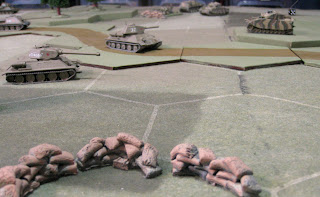Yesterday Bob Black and his wife Sue paid a visit, and after a light lunch and extensive wargaming discussion the two Bobs settled down for a short wargame.
I was keen to play test my 'Tank Action' rules, which are an adaptation of Charles Grant's rules from his book 'Battle'. Movement and firing distances have been converted into hexes and and the whole armoured section is laid out on one side of A4. Here are the rules:
The battle takes place on the Eastern front in 1943, with the Soviets exploiting gains following the battle of Kursk. The Germans are pulling back to a new defence line around the Dneiper river and seeing an opportunity, a soviet Guards Tank regiment is rushing forward to cut off the retreating enemy. They quickly outpace their infantry and artillery and hurtle headlong into a delaying force defending a low ridge. I played the Soviets while Bob controlled the Germans.
The soviet mission is to capture a small village, which is at the centre of the German delaying force position.
The Soviets advance towards the low ridge and the village objective is visible at the top of the table:
The Soviet force is made up of a large number of T-34 tanks of both 76 and 85mm variety and a lone tank destroyer. In all there are 15 tanks.The Germans hold the village with a mix of Panzer IV tanks and anti-tank guns:
A major asset for the Germans is an 88mm gun hidden in a small wood, covering the road into the village:
The six German tanks are mostly concealed behind the low ridge:
Wishing to maintain momentum the Soviet leading tanks roar over the ridge to engage the germans, but quickly come under fire from two 75mm PAK 40s in defilade positions behind the ridge, the T-34s attempt to fan out and close in on the enemy, but are quickly taken out by the 88mm and flanking guns:
The initial soviet attack is blunted and their commander (me!) is shocked by the effectiveness of the ant-tank defence:
It was clear that small numbers of tanks would be picked off as they crossed the ridge and so the next few turns were spent bringing up as many tanks as possible in order to launch a mass attack towards the village:
Meanwhile, Bob brought up his Panzer IVs into firing positions along the high ground by the village:
As the Soviets shuffle into to position another T-34 is hit by a long range shot from the 88mm, which sits well out of range of the soviet tanks:
When ready the soviet tanks burst into view, coming under a hail of fire from the German tanks and anti-tank guns. Another two T-34s go up in flames:
However, through sheer weight of numbers the soviets continue to roll through. One of the German 75mm guns is destroyed along with a Panzer IV:
More Soviet tanks burst into the view and a close exchange of fire ensues (I only learnt from bitter experience how close the T-34s needed to be to take out the German armour). More Panzer IVs go up in flames and I actually thought that the tide was turning in favour of the soviets.
The T34s roll towards the village and victory - or so I thought:
The 88mm firing along the road and the remaining 75mm firing into the Soviet flank soon changed all this, as the exposed Soviet tanks suffer the same fate as those earlier:
Having lost well over half of their number the Soviet attack faltered and the survivors reversed back over the ridge. It was a German victory and Bob and I retired to discuss the battle and the rules over tea. If the soviets had artillery and or infantry the outcome may have been different as the German anti-tank guns could have been neutralised.
The rules worked well, especially the observation/visibility element. The final score was 9 - 4 to the Germans!
The vehicles, 88mm and tanks are all Roco Minitanks, with Airfix 75mms. the game was played on a 5" hex board.



















Great looking stuff Bob…
ReplyDeleteI think the Russians know how those fish in the barrel felt…
All the best. Aly
I am writing this response from the gulag following my defeat, but secretly Supreme High Command acknowledge that it was an impossible mission without infantry and artillery support!
Delete